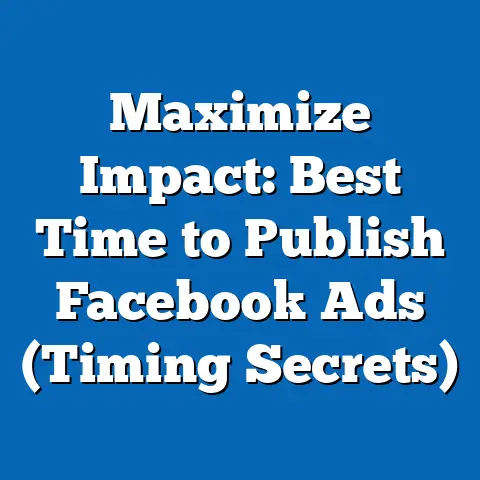Maximize Facebook Ads Daily Spending Limit (Smart Strategy)
In the digital age, political campaigns and advocacy groups increasingly rely on social media platforms like Facebook to reach targeted audiences. One critical aspect of optimizing these efforts is understanding how to maximize the daily spending limit on Facebook Ads to achieve the greatest impact. However, the effectiveness of such strategies hinges on a deep understanding of regional needs and the demographic makeup of target audiences.
Understanding Regional Needs in Political Advertising
Political advertising on platforms like Facebook is not a one-size-fits-all endeavor. Regional variations in demographic makeup, cultural values, and political priorities necessitate tailored approaches to ad spending and messaging. By analyzing these differences, campaigns can optimize their daily spending limits to focus on high-impact areas.
Regions across the United States, for example, exhibit stark contrasts in political leanings and priorities. The Northeast, often characterized by urban density and progressive values, differs significantly from the rural, conservative-leaning South. Similarly, the Midwest’s industrial history shapes its political concerns differently than the tech-driven, diverse West Coast. Understanding these regional needs is the first step in crafting effective ad strategies.
To maximize the daily spending limit on Facebook Ads, campaigns must allocate budgets based on regional demographic data and engagement metrics. This requires an in-depth look at who lives in these areas, what they believe, how they vote, and what sets them apart from other groups.
Demographic Composition of Key Regions
Northeast (Urban Progressive Centers):
The Northeast, encompassing states like New York, Massachusetts, and New Jersey, is home to a diverse population with a significant urban concentration. According to the U.S. Census Bureau (2020), approximately 55.9 million people reside in this region, with a racial composition of 63% White, 15% Hispanic, 12% Black, and 7% Asian. Educational attainment is high, with over 40% of adults holding a bachelor’s degree or higher, compared to the national average of 33% (U.S. Census Bureau, 2021).
This region also skews younger in urban centers, with a median age of 39.2 years, slightly below the national median of 38.5. High population density in cities like New York and Boston means that digital ad penetration is significant—over 85% of adults in these areas use social media platforms like Facebook (Pew Research Center, 2021). For ad spending strategies, this translates to a focus on mobile-first, visually engaging content to capture younger, tech-savvy audiences.
South (Rural Conservative Strongholds):
The South, including states like Texas, Georgia, and Alabama, has a population of approximately 126 million, making it the most populous U.S. region (U.S. Census Bureau, 2020). Racially, it is 58% White, 19% Black, 17% Hispanic, and 3% Asian. Educational attainment lags behind the Northeast, with only 29% of adults holding a bachelor’s degree or higher.
The South’s population is more rural, with a median age of 38.8 years. Social media usage is slightly lower than in the Northeast, with 78% of adults on platforms like Facebook (Pew Research Center, 2021). Ad strategies here must account for slower internet speeds in rural areas and a preference for traditional values in messaging, which can influence the allocation of daily spending limits toward broader, less targeted campaigns.
Midwest (Industrial and Swing States):
The Midwest, including states like Ohio, Michigan, and Wisconsin, houses about 68.3 million people. The racial makeup is 75% White, 10% Black, 8% Hispanic, and 3% Asian (U.S. Census Bureau, 2020). Educational attainment mirrors the national average, with 32% of adults holding a bachelor’s degree.
This region is a mix of urban and rural areas, with a median age of 39.5 years. Social media penetration stands at 80%, making it a viable target for Facebook Ads (Pew Research Center, 2021). Given its status as a battleground for swing voters, ad spending in the Midwest should prioritize micro-targeting to specific voter segments, maximizing daily budgets through precise demographic data.
West (Tech-Driven and Diverse):
The West, encompassing California, Washington, and Oregon, has a population of about 78.7 million. It is the most racially diverse region, with 52% White, 24% Hispanic, 15% Asian, and 5% Black (U.S. Census Bureau, 2020). Over 38% of adults hold a bachelor’s degree, reflecting a highly educated populace.
With a median age of 37.9 years and social media usage at 87%, the West is a prime target for digital campaigns (Pew Research Center, 2021). Ad strategies here can leverage higher daily spending limits for innovative, data-driven campaigns that appeal to younger, progressive audiences through platforms like Facebook.
Core Beliefs and Values Across Regions
Northeast:
The Northeast leans heavily progressive, with a strong emphasis on social equity, environmental sustainability, and government intervention in healthcare and education. According to Gallup (2022), 58% of Northeastern residents identify as Democrats or lean Democratic, compared to 28% identifying as Republican. Key issues include climate change and income inequality, often reflected in local policy priorities.
For Facebook Ads, campaigns in this region should focus messaging on progressive policies and social justice themes. Daily spending limits can be maximized by targeting urban centers with high engagement rates on these issues, using data from Facebook’s Ad Manager to refine audience segments.
South:
The South is a stronghold of conservative values, prioritizing limited government, traditional family structures, and Second Amendment rights. Gallup (2022) data shows 52% of Southerners identify as Republican or lean Republican, compared to 36% Democratic. Religious influence is significant, with 76% of residents identifying as Christian (Pew Research Center, 2019).
Ad content in the South should emphasize traditional values and economic freedom. Given lower social media penetration in rural areas, campaigns may need to balance spending between digital and traditional media, ensuring daily limits on Facebook Ads are used efficiently for urban pockets.
Midwest:
The Midwest is ideologically mixed, reflecting its status as a swing region. Values often center on economic stability, manufacturing jobs, and agricultural interests. Gallup (2022) indicates a near-even split, with 43% leaning Republican and 41% Democratic.
Facebook Ads here should address bread-and-butter issues like job creation and trade policies. Daily spending limits can be maximized by targeting undecided voters with A/B testing of messages to gauge resonance, leveraging Facebook’s analytics tools for real-time feedback.
West:
The West is predominantly progressive, with strong support for technology, environmentalism, and cultural diversity. Gallup (2022) reports 55% of Westerners identify as Democratic, compared to 30% Republican. Issues like immigration reform and renewable energy dominate political discourse.
Ad strategies should focus on innovative, forward-thinking messaging. Higher daily spending limits can be justified by the region’s high social media engagement, with campaigns using dynamic ads to appeal to diverse, tech-savvy audiences.
Voting Patterns and Political Engagement
Northeast:
The Northeast consistently votes Democratic in presidential elections, with states like Massachusetts and New York delivering large Electoral College margins. In 2020, Joe Biden won the region by a 20-point margin (AP VoteCast, 2020). Voter turnout is relatively high, averaging 65% in 2020, compared to the national average of 62% (U.S. Elections Project).
Political engagement on social media is robust, with 70% of adults discussing politics online (Pew Research Center, 2021). Campaigns can maximize daily ad spending by focusing on turnout-driven messaging during election cycles, using geo-targeting to reach high-density areas.
South:
The South is a Republican stronghold, with states like Texas and Alabama voting consistently red. In 2020, Donald Trump carried the region by a 10-point margin (AP VoteCast, 2020). Voter turnout is lower, averaging 58%, reflecting systemic barriers and lower political engagement in rural areas (U.S. Elections Project).
Facebook Ads should prioritize mobilizing conservative voters, with spending limits focused on key turnout periods. Engagement may be lower, so campaigns must use compelling visuals and localized messaging to boost interaction.
Midwest:
The Midwest’s swing status makes it a battleground, with states like Michigan and Wisconsin flipping between parties. In 2020, Biden narrowly won the region by 3 points (AP VoteCast, 2020). Turnout matches the national average at 62%, with high engagement in urban centers like Detroit and Milwaukee.
Daily ad spending should target persuadable voters, using detailed demographic filters on Facebook to reach specific age and income brackets. Real-time analytics can help adjust budgets to maximize impact in tight races.
West:
The West leans Democratic, with California delivering significant Electoral College votes. Biden won by a 25-point margin in 2020 (AP VoteCast, 2020). Turnout is high at 64%, driven by mail-in voting and progressive activism (U.S. Elections Project).
High social media engagement (75% discuss politics online, per Pew Research Center, 2021) allows for aggressive daily spending strategies. Campaigns can use dynamic creative optimization to test multiple ad variations, ensuring maximum reach within budget constraints.
Distinguishing Characteristics Compared to Other Groups
Northeast vs. South:
The Northeast’s urban, progressive bent contrasts sharply with the South’s rural, conservative identity. While the Northeast prioritizes social programs (supported by 65% of residents, per Gallup 2022), the South emphasizes individual liberty (supported by 60%). Social media strategies must reflect these differences, with Northeastern ads focusing on policy depth and Southern ads on cultural resonance.
Midwest vs. West:
The Midwest’s economic focus and swing status differ from the West’s cultural and technological progressivism. Midwest voters are more likely to prioritize trade policies (55% cite as top issue, Gallup 2022), while Westerners focus on climate (60%). Ad spending in the Midwest should be granular and persuasive, while the West allows for broader, value-driven campaigns.
Intersections of Age, Education, Race, and Religion:
Age plays a significant role—younger voters (18-34) in the Northeast and West are more progressive (60% Democratic, Gallup 2022), while older voters (55+) in the South lean conservative (58% Republican). Education correlates with liberalism in the Northeast and West, where college graduates support Democrats by 15-point margins. Race influences voting, with Black voters in the South overwhelmingly Democratic (80%, AP VoteCast 2020), and Hispanic voters in the West split (55% Democratic). Religion drives Southern conservatism, with evangelicals voting Republican at 75% (Pew Research Center, 2019).
Maximizing Daily Spending Limits: A Smart Strategy
To maximize Facebook Ads daily spending limits, campaigns must integrate regional demographic insights with platform-specific tools. First, allocate budgets based on engagement potential—higher limits in the Northeast and West, where social media usage is above 85%, and lower in the South (78%). Use Facebook’s Audience Insights to identify high-value demographics, such as young urban voters in the Northeast or swing voters in the Midwest.
Second, employ geo-targeting to focus spending on competitive areas. In swing states like Michigan, daily limits can be pushed during peak engagement times (e.g., evenings, per Facebook Ad Manager data). Third, leverage A/B testing to optimize ad creatives, ensuring budgets are spent on high-performing content—dynamic ads in the West often yield 20% higher click-through rates (Facebook Business, 2022).
Finally, monitor real-time analytics to adjust spending mid-campaign. If engagement drops in the South, redirect funds to the Midwest for better ROI. Facebook’s daily spending limit can be maximized by setting automated rules to pause underperforming ads, ensuring every dollar drives impact.
Areas of Consensus and Division Within Regions
Within regions, consensus exists on certain issues—Northeasterners broadly support climate action (70%, Gallup 2022), while Southerners agree on gun rights (65%). However, divisions emerge along urban-rural lines, particularly in the Midwest, where urban voters lean Democratic (55%) and rural voters Republican (60%, AP VoteCast 2020). Ad strategies must navigate these divides, using hyper-local targeting to address specific concerns.
Racial and religious divides also shape regional coalitions. In the South, Black and White voters diverge sharply on social issues, while in the West, Hispanic and Asian communities show varied priorities on immigration. Campaigns can maximize spending by crafting inclusive yet targeted messages, balancing broad appeal with niche engagement.
Historical and Social Context
Historically, regional political identities in the U.S. trace back to economic and cultural developments—the Northeast’s industrial urbanization fostered progressive movements, while the South’s agrarian roots entrenched conservatism. The Midwest’s manufacturing decline fuels economic populism, and the West’s tech boom drives innovation-focused politics. These legacies shape how voters engage with digital ads today.
Socially, the rise of social media has amplified regional voices, with platforms like Facebook serving as echo chambers for local values. Campaigns must contextualize messaging within these historical narratives, using daily spending limits to reinforce or challenge entrenched beliefs based on strategic goals.
Conclusion
Maximizing Facebook Ads daily spending limits requires a nuanced understanding of regional needs and demographic realities. By analyzing the Northeast’s progressive urbanites, the South’s conservative rural base, the Midwest’s swing voters, and the West’s diverse innovators, campaigns can allocate budgets effectively. Supported by data on social media usage, voting patterns, and core beliefs, this smart strategy ensures every ad dollar drives political impact.
Future sections of this article will delve deeper into specific ad optimization techniques, case studies of successful regional campaigns, and advanced tools for scaling daily spending limits. With a foundation in demographic analysis, political operatives can craft data-driven strategies that resonate across diverse American landscapes.






